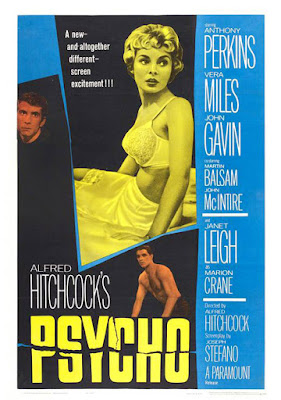Film Review - Psycho
 |
| Fig 1. Psycho poster (1960) |
The story of the film starts off with the audience following Marion as she steals $40,000, that she said would put in the bank for her boss, with the plan to give it to her boyfriend to clear his debts so they can marry. On her way, she stops off at the Bates Motel and meets Norman Bates, the owner. After a short talk about his mother, who had been seen at the window, Marion gets ready for bed by taking a shower however it soon becomes her own blood that starts to run down the plug hole. With this twist the story starts to focus on Sam and Lila, Marion’s boyfriend and sister, as they try to work out what happened to her.
The soundtrack used played a key role in building the tension before suddenly jumping out at the audience. People who haven’t even seen the film know the music and the role it plays in suddenly shocking the viewer and what it is represents when it is used to portray a particular type of scene, be it when it is used in parodies or scenes that pay homage to the film. “The violins wailing away during Psycho's shower murder scene have achieved the status of cultural shorthand - denoting imminent violent insanity.” (Robb, 2010) Even when the iconic violins are not being used the music still gives the viewer the idea that the characters are on edge, most notably is when Marion in driving in her car and she starts thinking about what the other characters are talking about. We get the feeling that she is slightly panicking inside and questioning if she should turn back round.
Unlike Hitchcock’s other film Rope, Psycho uses multiple camera cuts from multiple angles to create a feeling of unease and panic. This tactic is most notably used in the famous shower scene so the viewer feels that they are being attack from all sides. Even in later scenes the way that the camera changes, often to an angle that the human eye is not used to seeing, and the action suddenly happens straight after gives audience no time to prepare. This can be mostly noticed when the second murder takes place as “Hitchcock cuts disorientatingly to a bird's-eye view of the landing, and then, before we've had even a second to get our bearings, a figure darts into view from the right of the screen, knife raised.” (Monahan, 2015) With this the viewer feels like they have been suddenly attacked like the character while still trying to work out what just happened.
 |
| Fig 2. High angle, High impact (1960) |
Even filming in just black and white helped the film keep its suspense. The sets become more shadowy and intimidating making the audience feel just as on edge as the characters but this was a clever move by Hitchcock as he chose to film this way because it would make people focus on what is important. “The ominous tone of the film as shadows and small views of lighted objects create disturbing contrasts while also focusing the audience's attention where the director desires it to be.” (Enotes, 2014) This made sure that nothing was lost and that the small things didn’t slip past the viewer such as the light areas angling in on the money making of a greater impact when Norman gets rid of it not really knowing what is really is.
Hitchcock used his Bomb Theory throughout the film but one clever way in which he uses it is in the movie’s trailer. He is seen walking around the film’s set dropping hints and pointing out events that happen in the film as if it was the scene of a real murder, he tells the viewer all this information so that when they see Psycho they feel completely helpless as they can’t tell the character’s to get away or to not go into a particular room.
Illustration
- Figure 1. Psycho poster (1960) [Poster] At: https://milesherndon.com/blog/psycho-movie-poster-redesign (Accessed on 24.01.2017)
- Figure 2. High angle, High impact. (1960) [Film still] At: https://moviepilot.com/posts/3584915 (Accessed on 09.02.2017)
- Enotes. (2014) What are some film techniques used in the film Psycho by Alfred Hitchock? At: https://www.enotes.com/homework-help/film-techniques-used-film-psycho-by-alfred-470093 (Accessed on 09.02.2017)
- Monahan, Mark. (2015) Psycho, review. At: http://www.telegraph.co.uk/culture/film/filmreviews/11025424/Psycho-review.html (Accessed on 09.02.2017)
- Robb, Stephen. (2010) How Psycho changed cinema At: http://news.bbc.co.uk/1/hi/magazine/8593508.stm (Accessed on 24.01.2017)
Excellent Rhia :)
ReplyDeleteCouple of things... be careful of statements like this -
'When we think of Alfred Hitchcock, we think of only one film – Psycho (1960)'
You are making a generalisation here... you are assuming that everyone would think of this one film, when that is not the case.
Make sure that you put the date by the other film names too, so that the reader can get the sense of how they are related time wise. Also, don't assume that the reader has previous knowledge of things like the 'ticking bomb theory'...always make explain any ideas like this.